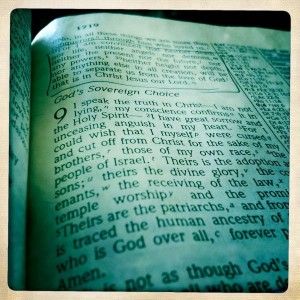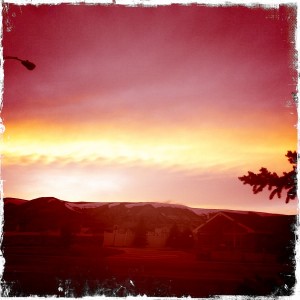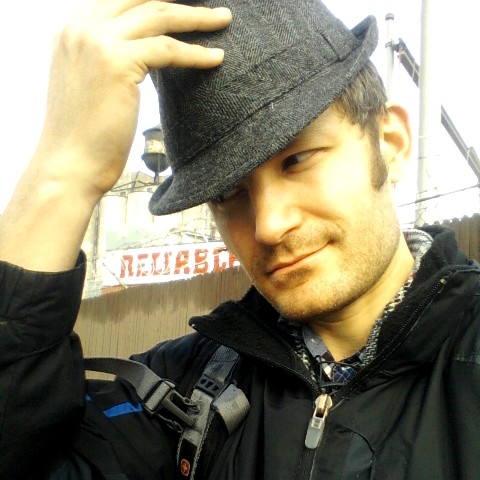The End of Moses and the Beginning of the Year – Part 1
26 Sep 2011 3 Comments
in Bible, Jewish praxis, Theology
For erev Shabbat last week, I got the chance to deliver a parsha teaching at my friend, Heather Blecher’s flat. Heather is an accomplished, young adult leader of Chicago’s Jewish-Christian community, worshiping with an evangelical congregation in Evanston and serving as a senior ministry partner with the Skokie branch of the non-profit, para-church organization, Jews for Jesus. Beyond this, Heather is a gifted photographer who distributes her prints through etsy, posts one shot a day on tumblr, was recently featured on imagekind.com, and occasionally exhibits her work in assorted coffee shops and art galleries across Chicago and New York. It’s always an honor to partner with her, and I’m glad I got the chance to do so once again last week. To spice up this post accordingly, I included a couple of my favorite photos from Heather’s aforementioned tumblr blog, which you should obviously check out, pronto.
My ultimate goal in this post is to set up an analysis of a key portion of scripture that many Jews reflect upon during one of the most important times in the Jewish calendar, the same portion of scripture upon which I taught at Heather’s flat a few days ago. I want to do this from an explicitly Jewish-Christian angle, illustrating just what is at stake for followers of Jesus who want to better understand the Jewish roots of their faith so that they can more faithfully follow after Messiah. In order to pull off this sort of analysis, I have to lay out a prolegomena of sorts describing a bit more about Jewish life and practice so that the biblical analysis I mentioned is achievable at a deep rather than a superficial level. In other words, this post is not merely anthropological but hermeneutical; it is not just about various, whimsical facets of Jewish culture but about the context of holy scripture, our attention to which will enable us to engage with God in a vital way that has been often neglected in the church. My next post in this series will deal with the in-depth, biblical analysis; this post will properly set it up. Let’s get rolling by unpacking a few of those religious terms I casually tossed into the very first sentence of this post. When is “erev Shabbat” and just what on earth is a “parsha”?
Jewish people measure the beginning of a given day from nightfall of the one that precedes it. Hence, a lot of religious observances scheduled to occur on a given day in the Jewish calendar get inaugurated the previous night–you know, because that’s technically already the next day. Hence, there’s a pretty frequent use of the term “erev” referring to the night preceding a given day, which is also the same thing as the very beginning of that day for a Jewish understanding of the ways that days and nights work. If this seems confusing, maybe this analogy will help clarify things a bit. For a Gregorian or Julian calendar, the first day of the week is Sunday and the last day of the week is Saturday, meaning that the weekend starts on Saturday morning and runs through Sunday night. But just about everybody knows that you really celebrate the weekend not on Saturday morning but on Friday night, right? The night before the technical weekend is so wrapped up in the observance of the weekend itself, it winds up getting functionally lumped together in our minds. (And parties, where applicable.) Well, something like this is true for the Jewish observance of every day, except that the evening before a given morning is technically a part of that morning and not just functionally a part of it. The linguistic marker of this fact is the term “erev,” the night before a given day that is also a part of that day.
Incidentally, the effect of this arrangement is such that one often wakes up on the morning of a spiritually significant day that has already begun and has in some part been commemorated before one went to sleep the previous night. To illustrate the significance of this way of doing things, the average, observant Christian does not associate Saturday night with a Sunday worship service, and the average Sunday morning is often frenetically paced. (Some buddies of mine actually leveraged this fact by planting a church in Brooklyn whose Sunday services began at 6pm.) In contrast, the average Jew does associate Friday night with a Saturday worship service, and they will have prepared themselves to participate in the latter with a focused yet relaxed rhythm on Friday night–literally going to sleep and waking up again in a state of rest devoted to worshiping the Living God and celebrating this blessing with their families and community of faith.
The key term in Hebrew for the seventh day of the week is שבת, i.e. “Shabbat,” or what most English speaking people call “The Sabbath.” Not only is this the final day of the week, it is the only day of the week with a proper name in scripture. In Hebrew, the other days of the week are given nicknames for their distance from Shabbat; that’s how ridiculously important Shabbat is for an observant Jew. Moreover, Shabbat it is the only day of religious observance mentioned in what is popularly called The Decalogue, or “The Ten Commandments” recorded in Exodus 20:1-17 and Deuteronomy 5:6-21. These are ten of the most important instructions delivered to the Jewish people out of all 613 commandments articulated in the Torah, the first five books of the Bible, and Shabbat receives more commentary than any other teaching in in those two, aforementioned portions of scripture.
In order to help Jewish people study scripture faithfully each week, the rabbis apportioned various selections from Torah into units for sequential study, called parshas. Each Shabbat, Jews are encouraged to study the given parsha selection, then meditate and act upon it over the course of the following week. So, last Friday night for erev Shabbat, i.e. the very beginning of Shabbat last week, I delivered a teaching on the parsha selection for the group of people Heather had rounded up at her flat. We also shared an awesome time of prayer, laughter, dialog, and the consumption of some utterly delicious food and drink, but those are topics of discussion for another time.
I’m going to move towards wrapping up this post by mentioning one detail that will provide a nice pivot for part two of this series. According to the Jewish calendar, this present week spans Elul 26, 5771 to Tishrei 3, 5772. Whereas the common era calendar measures everything with reference to the birth of Christ circa 1 B.C.E. and 1 C.E. (even though it’s pretty likely that Jesus was actually born around 4 B.C.E.), the Jewish calendar measures everything from the date it has calculated the creation of the world for religious purposes, which corresponds to 3761 B.C.E. The months are also run on a strictly lunar cycle and given different names than, say, the Gregorian or Julian calendars; hence, today is the 27th day of the month of Elul in year 5771 for the Jewish calendar and also the 26th day of the month of September in year 2011 for the Julian and Gregorian calendars.
Now, you may have noticed in the second sentence of the above paragraph that the parsha actually runs right across the new year according to the Jewish calendar; we’re going from the end of the month of Elul 5771 to the beginning of the month of Tishrei 5772. The festival marking this shift is one of the four most important holidays for Jewish faith and practice, holidays so important that one was supposed to suspend all normal work in order to properly connect with God through them such that one could be excommunicated from the Jewish community for callously disregarded their significance back in the days when scripture was being codified. Those “big four” holidays are Shabbat, Rosh Hashanah, Yom Kippur, and Pesach. And just to make things interesting, while it is Rosh Hashanah that functionally serves as the Jewish new year, the day falling right in the middle of the week for which our parsha section is reserved, it is actually Pesach that technically serves as the marker for the Jewish new year.
Sort of.
Alright, I cannot leave this post dangling on such an apparent contradiction; so, here’s one way to understand the matter. The central, religious event for the Jewish people recorded in first five books of the Bible is God’s miraculous deliverance of the Jewish people from hundreds of years of bondage and slavery in Egypt. This single event predicated everything that followed in such a fundamental way that God literally reset the Jewish calendar to commemorate it, and this is precisely what Pesach, also known as “The Passover,” accomplishes. I love how the first couple verses of Exodus 12:1-28 illustrate the matter, where God says to Moses and his brother, Aaron, “This month shall be for you the beginning of months. It shall be the first month of the year for you.” It’s like God is saying, “What I am doing right now on your behalf will blow your minds so much, it is so completely unprecedented, I want you to rearrange your entire year around it.” So the first two weeks of the Jewish year during the month of Nisan are devoted to ramping up to Pesach, and there is an entire week of celebration afterwards named the Feast of Unleavened Bread to protract the lesson. In other words, Jews take three weeks to celebrate the new year, and the most important point of time over that period isn’t the first day of the year but twilight just before the morning of the fifteenth!
A similar thing happens as we go deeper into the year and approach Yom Kippur, also known as “The Day of Atonement,” which commemorates God’s process of making amends or reparations for the sins of the Jewish people and thereby reconciling them back again to God’s self. Remember how we took two whole weeks to ramp up to Pescah? Well, we take ten days to ramp up to Yom Kippur nicknamed “the days of awe,” which begin with Rosh Hashanah. Now, Rosh Hashanah is actually a Hebrew nickname meaning “the head of the year” for the more biblical term in Leviticus 23:24, “The Day of Sounding,” which refers to the trumpets whose blast indicated to everybody within earshot that the gradual ramping up towards Yom Kippur had begun. The Jewish rabbis would later develop the concept of four different new years commemorating the beginning of different parts of our world. Pesach commemorates the beginning of the salvific relationship God established with the Jewish people by liberating them from slavery in Egypt and, consequently, the beginning of all holidays. Perhaps in some part due to the significance of forgiveness and the removal of sins commemorated by Yom Kippur, the rabbis treated Rosh Hashanah as the day when the world was created; that’s why the calendar actually advances a year on Rosh Hashanah and why it gets that nickname, “the head of the year.”
What all this means for our purposes is that the parsha for this week, Deuteronomy 29:9 – 31:30, spans an incredibly significant period of time for the Jewish calendar, the week when observant Jews celebrate the creation of the world and begin to prepare themselves to encounter God on a day devoted to recognizing their need for forgiveness and the removal of sins as a people. I’m going to go out on a limb here to say that the rabbis picked this parsha with care; they meant for us to meditate on the truths of scripture in that aforementioned context of observance and meditation on these key aspects of our relationship with God.
Paradoxically, while Jews are supposed to reflect upon this parsha selection near the end of Deuteronomy over a week that includes a day dedicated to remembering God’s creation of the world, a day marking the turnover of the Jewish calendar and, hence, a celebration of the beginning of the new year in Rosh Hashanah, the actual scriptural content of the parsha marks the end of one of the most important figures in all of the Bible, Moses. What’s the significance of that detail? Well, now now that we’ve done the work of establishing more of a culturally edifying context to explore this passage of scripture, we can turn to an in-depth analysis of it.
Next time…











3 Comments (+add yours?)